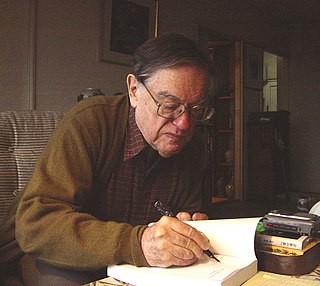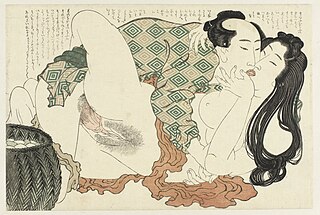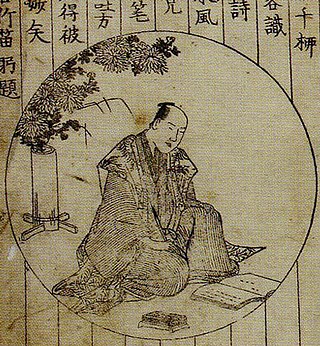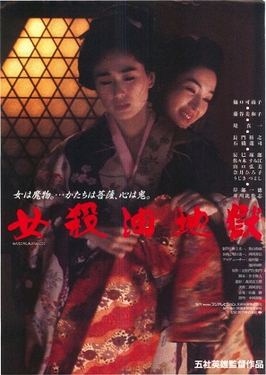Related Research Articles

Kabuki is a classical form of Japanese theatre,mixing dramatic performance with traditional dance. Kabuki theatre is known for its heavily stylised performances,its glamorous,highly decorated costumes,and for the elaborate kumadori make-up worn by some of its performers. The term kabuki originates from a verb that was used to describe young samurai patrons,meaning "being weird" or "offbeat."

Chikamatsu Monzaemon was a Japanese dramatist of jōruri,the form of puppet theater that later came to be known as bunraku,and the live-actor drama,kabuki. The Encyclopædia Britannica has written that he is "widely regarded as the greatest Japanese dramatist". His most famous plays deal with double-suicides of honor bound lovers. Of his puppet plays,around 70 are jidaimono (時代物) and 24 are sewamono (世話物). The domestic plays are today considered the core of his artistic achievement,particularly works such as The Courier for Hell (1711) and The Love Suicides at Amijima (1721). His histories are viewed less positively,though The Battles of Coxinga (1715) remains praised.

Donald Lawrence Keene was an American-born Japanese scholar,historian,teacher,writer and translator of Japanese literature. Keene was University Professor emeritus and Shincho Professor Emeritus of Japanese Literature at Columbia University,where he taught for over fifty years. Soon after the 2011 Tōhoku earthquake and tsunami,he retired from Columbia,moved to Japan permanently,and acquired citizenship under the name Kīn Donarudo. This was also his poetic pen name and occasional nickname,spelled in the ateji form 鬼怒鳴門.

Bunraku is a form of traditional Japanese puppet theatre,founded in Osaka in the beginning of the 17th century,which is still performed in the modern day. Three kinds of performers take part in a bunraku performance:the Ningyōtsukai or Ningyōzukai (puppeteers),the tayū (chanters),and shamisen musicians. Occasionally other instruments such as taiko drums will be used. The combination of chanting and shamisen playing is called jōruri and the Japanese word for puppet is ningyō. It is used in many plays.

Shunga (春画) is a type of Japanese erotic art typically executed as a kind of ukiyo-e,often in woodblock print format. While rare,there are also extant erotic painted handscrolls which predate ukiyo-e. Translated literally,the Japanese word shunga means picture of spring;"spring" is a common euphemism for sex.

Traditional Japanese theatre is among the oldest theatre traditions in the world. Traditional theatre includes Noh,a spiritual drama,and its comic accompaniment kyōgen;kabuki,a dance and music theatrical tradition;bunraku,puppetry;and yose,a spoken drama.
The Love Suicides at Amijima is a domestic play (sewamono) by Japanese playwright Chikamatsu Monzaemon. Originally written for the bunraku puppet theatre,it was adapted into kabuki shortly after its premiere on 3 January 1721. It is widely regarded as one of his greatest domestic plays and was hailed by Donald Keene as “Chikamatsu’s masterpiece”.

Konishi Hirosada was the most prolific Osaka-based designer of ukiyo-e woodblock prints during the late Edo period. Like most producers of kamigata-e (上方絵)—prints originating in the Osaka and Kyoto regions—he specialized in yakusha-e actor prints. Hirosada is particularly known for his diptychs and triptychs,and for his many ōkubi-e portraits of the leading actors on the Osaka kabuki stage during his day.

Namiki Sōsuke,also known as Namiki Senryū,was a prominent Japanese playwright who wrote for both kabuki and bunraku. He produced around 47 bunraku plays,nearly 40 of them composed for jōruri,a particular form of musical narrative,and 10 kabuki plays. He is considered the second greatest Japanese playwright after Chikamatsu Monzaemon.
The Love Suicides at Sonezaki is a jōruri play by the Japanese playwright Chikamatsu Monzaemon. The double suicides that occurred on May 22,1703 inspired Chikamatsu to write this play and thus The Love Suicides at Sonezaki made its debut performance on June 20,1703. Chikamatsu added new scenes in the 1717 revival including the villain's punishment. The Love Suicides at Sonezaki's reception was popular and helped springboard Chikamatsu's future success as a playwright. In the first year alone since the play's premiere,no less than seventeen couples committed double suicide. In fact,the bakufu banned Chikamatsu's shinjūplays in 1722 because of their content's popularity. The Love Suicides at Sonezaki was Chikamatsu's first "domestic tragedy" or "domestic play" (sewamono) and his first love-suicide play (shinjūmono). Until this play,the common topic for jōruri was jidaimono or "history plays" while kabuki performances showed domestic plays. The Love Suicides at Sonezaki separates into three scenes,staged over a day and a night. The two central characters are an orphaned oil clerk named Tokubei and Ohatsu,the courtesan he loves. There is a beginning scene that shows Ohatsu going on a pilgrimage that performances and translations often leave out. This play also includes a religious aspect involving Confucianism and Buddhism.
The Takemoto-za (竹本座) was a bunraku theatre in Osaka,founded in 1684 by Takemoto Gidayū. Plays by many famous playwrights were performed there,including works by Chikamatsu Monzaemon,Namiki Sōsuke,and Takeda Izumo I. Many of the playwrights working at the Takemoto-za worked together,as a committee,as was the custom at the time.
Christopher Shackle,is Emeritus Professor of Modern Languages of South Asia at the University of London.
Jo-ha-kyū (序破急) is a concept of modulation and movement applied in a wide variety of traditional Japanese arts. Roughly translated to "beginning,break,rapid",it essentially means that all actions or efforts should begin slowly,speed up,and then end swiftly. This concept is applied to elements of the Japanese tea ceremony,martial arts,dramatic structure in the traditional theatre,and to the traditional collaborative linked verse forms renga and renku.
Takemoto Gidayū was a jōruri chanter and the creator of a style of chanted narration for Japan's puppet theatre which has been used ever since. The name "gidayū" has since become the term for all jōruri chanters. He was a close colleague of the famous playwright Chikamatsu Monzaemon,and founder and manager of the Takemoto-za puppet theatre.
Ronald Cavaye is a British pianist,born in England and a resident of the United Kingdom. He is a classical pianist and writer.

Sakata TōjūrōI was an early kabuki actor of the Genroku period in Japan. He was a pioneer of the wagoto style,and of Kamigata kabuki more generally. His influence persists in the lineage of actors who have taken up his artistic mantle.

The Oil-Hell Murder is a 1992 Japanese film directed by Hideo Gosha. It was Japan's submission to the 65th Academy Awards for the Academy Award for Best Foreign Language Film,but was not accepted as a nominee.
Gary Gerstle is an American historian and the Paul Mellon Professor of American History at the University of Cambridge,and a Fellow of Sidney Sussex College.

Genroku culture is the term used to describe the culture of the early Edo period (1603–1867),in particular the Genroku era of 1688–1704. Genroku culture is known as a period of luxurious display when the arts were increasingly patronized by a growing and powerful merchant class. The Genroku period is associated with two pleasure zones:the brothel district and the theaters. These two areas were often located near each other on the margins of respectable society. These constituted the ukiyo celebrated in woodblock prints of prostitutes,actors,and pornography.

Donald Howard Shively was an American academic,historian,Japanologist,author and professor emeritus of East Asian Languages and Cultures at the University of California,Berkeley. He was a leader of Japan studies in the United States.
References
- ↑ Columbia College (Columbia University). Office of Alumni Affairs and Development; Columbia College (Columbia University) (2015–2016). Columbia College today. Columbia University Libraries. New York, N.Y. : Columbia College, Office of Alumni Affairs and Development.
- ↑ "Gerstle, Prof. (C.) Andrew", Who's Who (online edition, Oxford University Press, December 2017). Retrieved 30 June 2018.
- 1 2 "Andrew Gerstle", SOAS University of London. Retrieved 30 June 2018.
- ↑ "Circles of fantasy : musical and dramatic conventions in the plays of Chikamatsu", HOLLIS: Harvard University Library Catalogue. Retrieved 30 June 2018.
- 1 2 "Professor Andrew Gerstle", British Academy. Retrieved 30 June 2018.